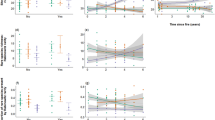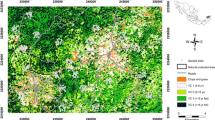Abstract
A multivariate linear regression model is proposed for predicting and mapping rare vascular plant species richness in Finnish agricultural landscapes according to landscape variables. The data used in developing the model were derived from a floristic inventory from 105 0.5 km × 0.5 km grid squares. Using a stepwise multiple regression technique, four landscape variables were found to explain 71.8% of the variability in the number of rare plant species. The results suggest that the local `hotspots' of rare plants (squares with ≥5 rare taxa) are mainly found in heterogeneous river valleys, where extensive semi-natural grasslands and herb-rich forests occur on the steep slopes. According to other similar studies, intermediate human disturbance increases the number of rare species in agricultural landscapes. It appears that empirical models based on landscape variables derived from digital maps can provide relatively accurate surrogates for extensive field surveys and fine-scale observations on the distributions of rare taxa in agricultural landscapes. Potential reasons for the performance of the model and the ecology and habitats of the species concerned are discussed.
Similar content being viewed by others
References
Alatalo, R. V. 1981. Problems in the measurement of evenness in ecology. Oikos 37, 199–204.
Begon, M., Harper, J. L. & Towsend, C. R. 1996. Ecology: individuals, populations and communities. Blackwell Science, Oxford.
Bornette, G. & Amoros, C. 1996. Disturbance regimes and vegetation dynamics: role of floods in riverine wetlands. J. Vege. Sci. 7: 615–622.
Buckland, S. T. & Elston, D. A. 1993. Empirical models for the spatial distribution of wildlife. J. Appl. Ecol. 30: 478–495.
Cain, D. H., Riitters, K. & Orvis. K. 1997. A multi-scale analysis of landscape statistics. Landsc. Ecol. 12: 199–212.
Climatological Statistics in Finland 1961- 1990. 1991. Supplement of meteorological yearbook of Finland. Finnish Meteorological Institute, Helsinki, 125 pp.
Eyre, M. D. & Rushton, S.P. 1989. Quantification of conservation criteria using invertebrates. J. Appl. Ecol. 26: 159–171.
Farina, A. 1997. Landscape structure and breeding bird distribution in a sub-Mediterranean agro-ecosystem. Landsc. Ecol. 12: 365–378.
Forman, R. T. T. 1995. Land mosaics. The ecology of landscapes and regions. Cambridge University Press, Cambridge, 632 pp.
Gao, Q. & Yang, X. (1997). A relationship between spatial processes and a partial patchiness index in a grassland landscape. Landsc. Ecol. 12: 321–330.
Gaston, K. J. 1994. Rarity. Chapman & Hall, London.
Gaston, K. J. 1996. Species richness: measure and measurement. Pp. 77–113. In: Gaston, K. J. (ed.), Biodiversity. A biology of numbers and difference. Blackwell Science, Oxford.
Hair, J. F. Jr., Anderson, R. E., Tatham, R. L. & Black, W. C. 1992. Multivariate data analysis. Macmillan Publishing Company, New York, 544 pp.
Hämet-Ahti, L., Suominen, J., Ulvinen, T. & Uotila, P. 1998. Retkeilykasvio (Field Flora of Finland). Finnish Museum of Natural History, Botanical museum, Helsinki, 656 pp. (in Finnish with English summary).
Heikkinen, Risto 1997. Can richness patterns of rarities be predicted from mesoscale atlas data? A case study of vascular plants in the Kevo Reserve. Annales Universitatis Turkuensis A II 96. University of Turku, 1–19.
Hill, N. M. & Keddy, P. A. 1992. Prediction of rarities from habitat variables: coastal plain plants on Nova Scotian lakeshores. Ecology 73: 1852–1859.
Huston, M. A. 1994. Biological diversity. The coexistence of species on changing landscapes. Cambridge University Press, Cambridge, 681 pp.
Jonsen, I. A. & Fahrig, L. 1997. Response of generalist and specialist insect hebivores to landscape spatial structure. Landsc. Ecol. 12: 185–197.
Kinnunen, H., Järveläinen, K., Pakkala, T. & Tiainen, J. 1996. The effect of isolation on the occurence of farmland carabids in a fragmentated landscape. Ann. Zool. Fennici 33: 165–171.
Kolström, M. & Pitkänen, S. 1999. Effects of forest management on alpha diversity of ground vegetation in boreal forests: a model approach. Boreal Environ. Res. 4: 45–54.
Kontula, T., Lehtomaa, L. & Pykälä, J. 1999. Rekijokilaakson maankäytön historia, kasvillisuus ja kasvisto. Finnish Environment, in press. Finnish Environment Institute, Helsinki (in Finnish with English summary).
Kotiranta, H., Uotila, P., Sulkava, S. & Peltonen, S-L. 1998. Red Data Book of East Fennoscandia. Ministry of the Environment, Finnish Environment Institute, Finnish Botanical Museum, Finnish Museum of Natural History, Helsinki, 351 pp.
Margules, C. R. & Usher, M. B. 1981. Criteria used in assessing wildlife conservation potential: a review. Biol. Cons. 21: 79–109.
McGarical, K. & Marks, B. J. 1994. Fragstats, spatial pattern analysis program for quantifying landscape structure. Version 2.0. Forest Science Department, Oregon State University, Corvallis, Oregon, 67 pp.
McIntyre, S. & Lavorel, S. 1994. Predicting richness of native, rare and exotic plants in response to habitat and disturbance variables across a variegated landscape. Cons. Biol. 8: 521–531.
Miller, R. I. 1986. Predicting rare plant distribution patterns in the southern Appalachians of the south-eastern U.S.A. J. Biog. 13: 293–311.
Miller, J. S., Brooks, R. P. & Croonquist, M. J. 1997. Effects of landscape pattern on biotic communities. Landsc. Ecol. 12: 137–153.
Natuhara, Y. & Imai, C. 1999. Prediction of species richness of breeding birds by landscape-level factors of urban woods in Osaka prefecture, Japan. Biodiv. Cons. 8: 239–253.
Nicholls, A. O. 1989. How to make biological surveys go further with generalised linear models. Biol. Cons. 50: 51–75.
Nicholls, A. O. 1991. Examples of the use of Generalised linear models in analysis of survey data for conservation evaluation. Pp. 54–63. In: Margules, C. R. & Austin, M. P. (eds), Nature conservation: Cost effective biological surveys and data analysis. CSIRO, Australia.
Nilsson, C., Grelsson, G., Johansson, M. & Sperens, U. 1988. Can rarity and diversity be predicted in vegetation along river banks? Biol. Cons. 44: 201–212.
Noss, R. F. 1983. A regional landscape approach to maintain biodiversity. BioScience 33: 700–705.
Petit, S. & Usher, M. B. 1998. Biodiversity in agricultural landscapes: the groud beetle communities of woody uncultivated habitats. Biodiv. Cons. 7: 1549–1561.
Prendergast, J. R., Quinn, R. M., Lawton, J. H., Eversham, B. C. & Gibbons, D.W. 1993. Rare species, the coincidennce of diversity hotspots and conservation strategies. Nature 365: 335–337.
Rassi, P., Kaipiainen, H., Mannerkoski, I. & Stå hls, G. 1992. Uhanalaisten eläinten ja kasvien seurantatoimikunnan mietintö (English abstract: report on the monitoring of threatened animals and plants in Finland). Ministry of Environment, Helsinki.
Rossi, E. & Kuitunen, M. 1996. Ranking of habitats for the assesment of ecological impact in land use planning. Biol. Cons. 77: 227–234.
Shmida, A. & Wilson, M. V. 1985. Biological determinants of species diversity. J. Biogeog. 12: 1–20.
Suominen, J. & Hämet-Ahti, L. 1988. Ihmistoiminnan varhaisesta vaikutuksesta Suomen kasvistoon. (Early impact of man on the flora of Finland). Memoranda Societa Fauna Flora Fennica 64: 11–14.
Turner, M. G. 1989. Landscape Ecology: The Effect of Pattern on Process. Ann. Rev. Ecol. Syst. 20: 171–197.
White, P. S. & Miller, R. I. 1988. Topographic models of vascular plant richness of the southern Appalachian high peaks. J. Ecol. 76: 192–199.
Wohlgemuth, T. 1998. Modelling floristic species richness on a regional scale: a case study in Switzerland. Biodiv. Cons. 7: 159–177.
Author information
Authors and Affiliations
Rights and permissions
About this article
Cite this article
Luoto, M. Modelling of rare plant species richness by landscape variables in an agriculture area in Finland. Plant Ecology 149, 157–168 (2000). https://doi.org/10.1023/A:1026531400356
Issue Date:
DOI: https://doi.org/10.1023/A:1026531400356




